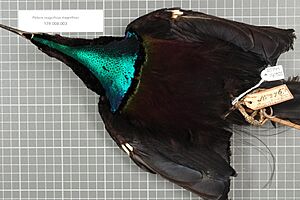Magnificent riflebird facts for kids
Quick facts for kids Magnificent riflebird |
|
|---|---|
 |
|
| Male magnificent riflebird perched. | |
| Conservation status | |
| Scientific classification | |
| Genus: |
Ptiloris
|
| Species: |
magnificus
|
| Synonyms | |
|
Craspedophora magnificus |
|
The magnificent riflebird (Ptiloris magnificus) is a special type of passerine bird. This means it's a perching bird, like many songbirds. It belongs to the amazing birds-of-paradise family. These birds are famous for their stunning looks!
You can find magnificent riflebirds in the lowland rainforests of western New Guinea. They also live in the northern Cape York Peninsula in Australia. These birds are quite common in their homes. Because of this, they are listed as a species of "Least Concern" by the IUCN Red List. This means they are not currently in danger of disappearing. They are also protected under CITES Appendix II. This international agreement helps control trade in wild animals and plants.
Discovering the Magnificent Riflebird
The magnificent riflebird was first officially described in 1819. A French bird expert named Louis Vieillot gave it the scientific name Falcinellus magnificus. Later, in 1825, an English naturalist named William Swainson placed it in the group, or genus, called Ptiloris.
The name "riflebird" comes from how the male bird looks. Its black, velvety feathers reminded people of the uniforms worn by the British Army's Rifle Brigade.
There are two main types, or subspecies, of magnificent riflebirds:
- P. m. alberti was named by Elliot in 1871. This type lives in the north of Cape York Peninsula, Australia.
- P. m. magnificus was named by Vieillot in 1819. This type lives in western and central New Guinea.
What Does a Magnificent Riflebird Look Like?
This riflebird is a medium-sized bird. It can grow to be about 34 centimeters (13 inches) long.
The male magnificent riflebird is truly stunning! It has velvet-black feathers. It also has long, thin black feathers on its sides. Its head has a shiny blue-green crown. A wide, triangle-shaped shield of bright, iridescent feathers covers its chest. Its central tail feathers are also shiny. The male has a black, curved beak, a yellow mouth, and dark brown eyes. Its feet are blackish.
The female looks quite different from the male. She is brownish with dark spots and light brown bars on her belly. She also has a white stripe above her eye. Young males look a bit like the adult males but have fewer tail feathers.
Behavior and Life Cycle
Magnificent riflebirds eat mostly fruits. They also enjoy a variety of small creatures. These include spiders and millipedes.
Male riflebirds are polygamous. This means one male will mate with several females. Each male performs a special dance all by himself. He does this on a favorite "dancing perch." During his dance, the male stretches his wings out wide. He also raises his tail. He then jerks his body upwards. He swings his head from side to side. This shows off his shiny blue-green chest shield. As he flaps his wings, he makes a unique "woosh" sound.
Many female riflebirds will watch these dances. If a female likes the male's performance, she will choose him to mate with. After mating, the female builds the nest. She also sits on the eggs to keep them warm. She feeds and takes care of the young birds all by herself. The male does not help raise the chicks.




